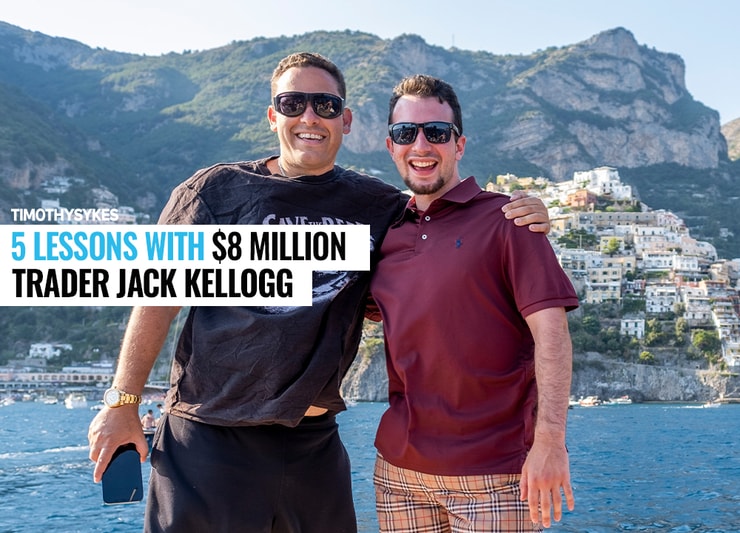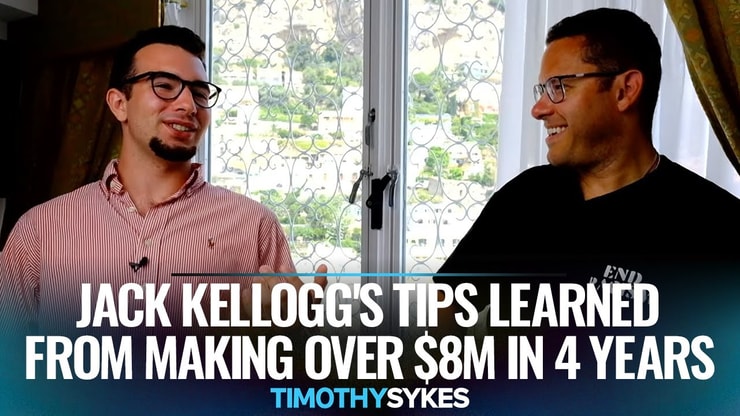5 Lessons With $8 Million Trader Jack Kellogg: Key Takeaways
- Jack pushed himself to the max — he couldn’t have done better the past year.* Read on to find out how he did it.
- Every setup has its limits. Know when to push it, and when to cut and walk away.
- PLUS: Jack’s BIG tip for how he plans to trade the next hot market. (Hint: watch the video…)
Trade with Jack, Kyle, and Mari
In August, I met up with six millionaire students in Italy. During the week I caught up with Jack Kellogg. In the eight months since we’d last talked, Jack had made an almost unheard-of (for penny stocks) $6 million in profits.*
Check out the video below. Then keep reading, because Jack also shared five lessons he thinks every new trader should learn…
Table of Contents
Jack Kellogg’s Tips to Over $8 Million in Profits In 4 Years

2025 Millionaire Media, LLCIn this video, you’ll learn…
- How Jack maximized during the hot market — including the strategies he used.
- The strategy Jack used to make over $1.3 million in one week.* (And how he took his biggest ever loss the same week by breaking one of his own rules.)
- What Jack learned from video games that helps him manage dozens of trades at once.
- Jack had to relearn THIS after pushing it harder than any trader I’ve ever seen. (And the price he paid for it.)
- How much Jack made on his biggest trade. Most people don’t make this much in a year.
- The story behind Jack’s first visit to an AMC theater. (Bet you can’t guess what he bought…)
Hopefully, that inspired you to study. Let’s do this…
5 Lessons With $8 Million Trader Jack Kellogg
I teach students to start small and focus on the process. When I asked Jack if he had five lessons to pass on to new traders, he didn’t hesitate. His first lesson is…
Risk What You’re Willing to Lose
In Jack’s words…
“For people starting out, I think that’s a big thing. A lot of people go into the markets and they go too big without enough knowledge. They just take themselves out of the game. It’s such a common error I see over and over again.
“People don’t really start small unless it’s pushed into their heads. Too many people see trading, open an account with $3,000, put it into a few stocks, and that’s it.
“If you took that $3,000, bought yourself some trading education, and started with $10 risk … you’d have a much greater chance of being successful.”
I agree with Jack 100%…
Jack’s next lesson is about something I think would change the entire industry if everyone did it. Here’s Jack’s take…
Be Transparent

“Being transparent is very important. It can help you keep from making the same mistake again.
“For instance, I know someone who made $100,000 in the hot market from a $10,000 account. Then he put his entire account into Tilray Inc. (NASDAQ: TLRY) when it dipped from $70 to $30. He bought the first green day at $32 with his whole account.
“But…
- He didn’t tell anybody he was doing it.
- He didn’t have a plan.
- And he wasn’t transparent about it.
“He ended up holding it. He’s still holding it now. (Tim here. As I write, TLRY is in the $10s.) He doesn’t tell anybody how much he’s down. And that means he’s doing it in the dark. Being transparent keeps you honest with yourself.
“If you’re honest with others, you’ll be honest with yourself. Personally, if I mess something up and tell somebody, it’s embarrassing. But I won’t make the same mistake again because I don’t want that feeling.
“If I made a mistake in the dark, and didn’t tell anyone, I’d probably make that mistake again. So, for me, I like to be transparent. I think if this kid was transparent, he wouldn’t have made that trade.”
The story didn’t have to end that way. There were multiple opportunities to get out of the trade for a small win or loss.
If the trader Jack is talking about got out today, his account would still be up roughly 200% from where he started. As it is, he’s waiting for TLRY to bounce. That’s just crazy. He’s missing SO much opportunity — not least of which is the opportunity to learn and refine his skills. Hold and hope is not a strategy.
Here’s Jack’s next lesson…
More Breaking News
- Unexpected Plunge in CCL: Buying Opportunity?
- Why TMC’s Stock Is Plummeting
- HTZ Faces Data Breach and Restructuring Woes
Don’t Add to Losers
Like all top traders, Jack takes losses. Sometimes it takes a big loss to learn a big lesson. I remember watching Jack on stage at my 2019 conference, and one of his rules was never add to a loser.
Jack’s biggest loss ever was on Medmen Enterprises Inc. (OTCQX: MMNFF). On that loss, he broke his own rule…
“On MMNFF, the problem was that I just went too big on it. I was making too much money and winning too much. I had something like two million shares and it was over a million-dollar position in an OTC.
“When it didn’t bounce right away, I averaged down. It ended up being a situation where I had to take a loss. So it was a matter of trying to cut intelligently.
“I wanted to get out at 60 cents a share, but there just wasn’t any liquidity. So I lost something like $200,000 in slippage, just trying to get out.”
I want to thank Jack for being so open about his loss. His transparency means everyone can learn from the trade. It also highlights one of three common mistakes traders make when dip buying too early.
Here’s Jack’s fourth lesson…
Long Is Better Than Short
Again, I couldn’t agree more. Short selling is a flawed strategy right now. For newbies and anyone with a small account, it’s dangerous. Here’s what Jack says about it…
“Longing is superior because you can only lose 100% of your money. With short selling, you could lose 500%.
“And there are a lot more fees involved with short selling. With longing, it’s commission-free on Nasdaqs now.
“Plus the SPY (S&P 500) is on a massive tear, so short selling is very difficult. For example, all the short sellers on Tesla (NASDAQ: TSLA) keep saying it’s a short. But it just keeps going up.
“With longing, you have the chance to make so much more without as much risk.”
Here’s Jack’s fifth lesson…
Start With OTCs
Again, I couldn’t agree more. Personally, I find OTCs easier to trade for a couple of reasons. First, they don’t trade after hours and any premarket trading is very small.
Second, with OTCs you can read Level 2. Listed stocks are usually a lot more choppy, so you have to focus on the chart more than Level 2. Here’s what Jack had to say…
“I’m focused on OTCs because Nasdaqs have been giving me a headache. They’re just harder for me personally. Kyle is very into them right now and doing very well with them. I’d just rather focus on OTCs.”
Tim here. I get that some traders prefer listed stocks. And that’s one of the advantages of Jack’s chat room…
Breakouts & Breakdowns

2025 Millionaire Media, LLCIt’s very satisfying having so many millionaire students now. And one of the best things is watching them give back to the community.*
Jack, Mari, and Kyle moderate the Breakouts & Breakdowns chat room on StocksToTrade.
Jack says Breakouts & Breakdowns is special because they focus on the entire 7-step framework…
“We trade the entire framework of hype. A lot of other chat rooms focus on one thing. Breakouts & Breakdowns tries to capture the full supernova. From the first breakouts, all the way to the top, and then shorting all the way down. And buying the dip, buying the first green day.”
He also gave props to his partner, Mari.
“Not many chat rooms have a female millionaire trader as a moderator. That separates us.”
Breakouts & Breakdowns is an add-on subscription for StocksToTrade. I can’t recommend it enough. Learn more about Breakouts & Breakdowns here.
Which of Jack’s 5 lessons helps you the most today? Comment below — and congratulate Jack on his massive year!
Disclaimers
*Results are not typical. Results are not typical. Always do your own research as trading is inherently risky. You should not mirror the trades or alerts of the instructors and attempts to do so may result in substantial financial loss. Past performance is not an indicator of future results. I’ve also hired Jack Kellogg, Kyle Williams, and Mariana Hincapie to help in my education business.
**Tim Sykes has a minority ownership stake in StocksToTrade.com.











Leave a reply